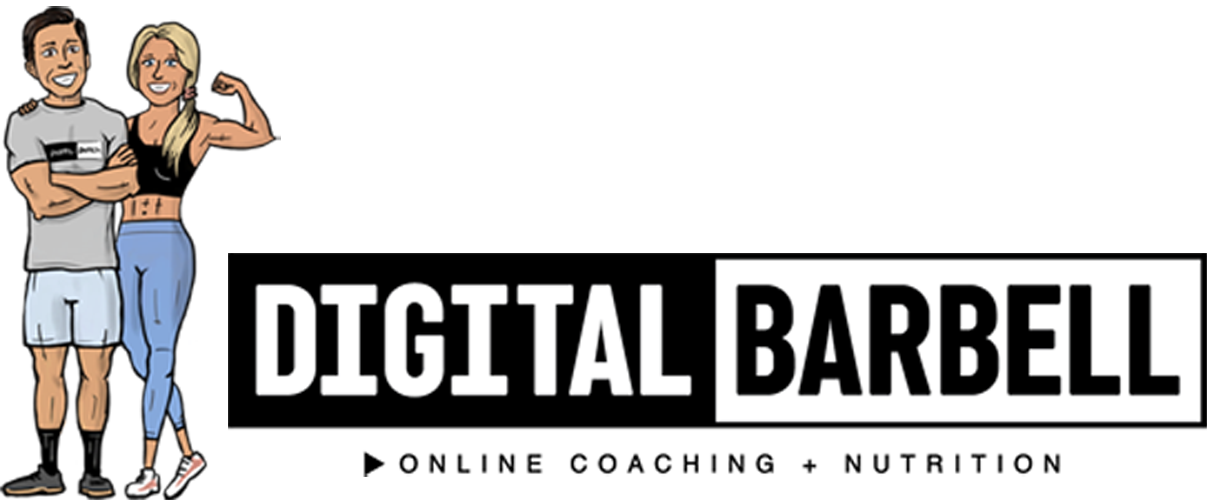WHY FOOD MATTERS
We talk a lot at Digital Barbell about food being our fuel or energy source. Just like gasoline fuels our cars to run, food fuels our bodies to run and gives us the energy that we need for all of our actions and activities. We may need this energy to take our kids to school, get groceries, cook dinner and put everyone to bed and we may also need this energy to hit the gym for an hour in-between all of this work.
To give you a bit better of an idea how the different energy systems work AND so that you’ll understand why we say what you eat matters… let’s dive in.
Our bodies have access to 3 different energy systems that they can utilize.
The Phosphagen System dominates the highest powered activities, specifically those lasting about 10 seconds.
When we need short, intense bursts of energy, ATP is synthesized using creatine phosphate (CP) that is stored in our muscles. It’s an extremely fast process, but it doesn’t last long since there is a limited amount of CP stored in our muscles. The process does not require any of our body’s oxygen which classifies it as an “anaerobic” event.
Athletes that rely on the phosphagen system would include short distance sprinters, Olympic Weightlifters, football lineman, and track and field athletes like shot putters or throwers.
We train this energy system in the gym by using loads approaching our 1 rep max, with plenty of rest between sets. Exercises like sprints and fast sled pushes are also excellent ways to train this system.
This system increases power and strength, improves cardiovascular health, burns body fat (even long after we’ve left the gym), builds muscle and aids in all sports and functions that we do in life. Proper fuel (aka food) is essential to fuel this system since we need both the energy to perform these actions as well as the muscle building amino acids (protein).
The Gylcolytic System dominates moderate-powered actives, those lasting up to several minutes.
Like the Phosphagen system, the Gylcolytic System does not use oxygen to produce energy. It’s Anaerobic and has the same benefits of the Phosphagen system mentioned above. The Glycolytic energy system kicks into gear after the Phospagen system has been depleted. This system uses the glucose/carbohydrates (sugar) in your blood, along with glucose that has been converted to glycogen and stored in the muscles and liver for energy.
The Glycolytic energy system can effectively provide energy to our muscles for about 2 minutes at high intensity.
Eventually our muscles build up an excess of hydrogen (a byproduct of the conversion of glucose) and they can no longer contract. That build up is what gives you that burning feeling in your muscles at high intensity.
We train this energy system by doing things like 30-40 second intervals with short rest in-between sets.
The Oxidative System dominates low-powered activities that last in excess of several minutes.
This system kicks in around the 2 minute mark of exercise once the anaerobic systems are spent and can power you with energy for a very long time. The oxidative system is aerobic (uses oxygen).
You cannot generate the same strong force that you can during the anaerobic phases, but you can work for much longer.
The oxidative system burns carbohydrates, fats and protein for energy but since it is an aerobic system it also burns muscle.
Total fitness requires training in each of these pathways. Aerobic training benefits cardiovascular functions and decrease body fat but can also decrease power, speed and muscle mass if doing it alone. Anaerobic activity also benefits cardiovascular functions and decreases body fat as well as improving power, speed and muscle mass.
Before any of this is attacked, a foundation in nutrition meaning how much and what to eat is key to overall health and performance as your nutrition will fuel your body for the activities you throw at it.
